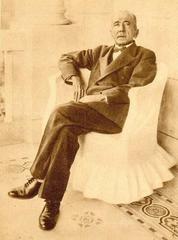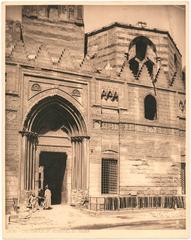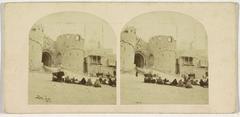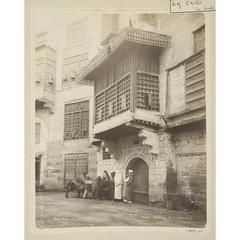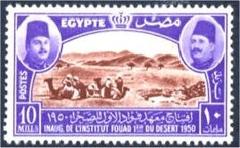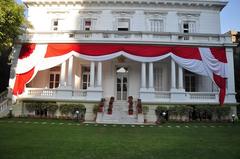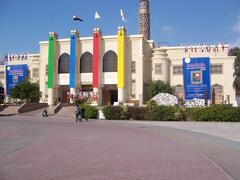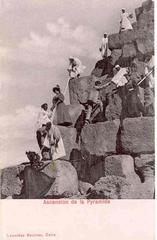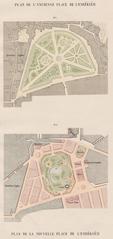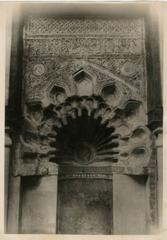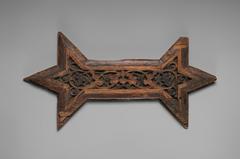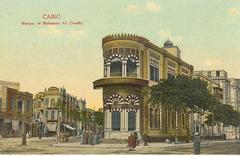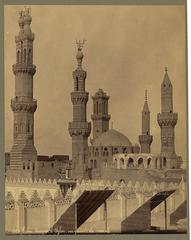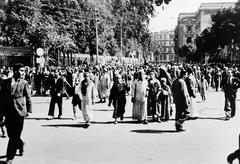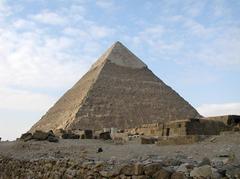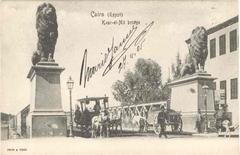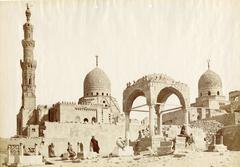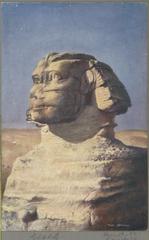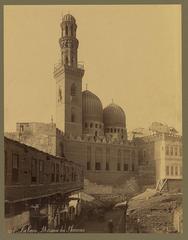
Complete Guide to Visiting Imbaba Bridge, Cairo, Egypt
Date: 24/07/2024
Introduction
The Imbaba Bridge, known locally as كوبري إمبابة, stands as an emblem of Cairo’s rich historical and architectural heritage. Constructed in 1892, this steel truss bridge has played a pivotal role in the transportation and social fabric of Egypt’s capital. Originally designed to facilitate railway traffic across the Nile River, the Imbaba Bridge has undergone several modifications and remains a critical infrastructural element to this day. Whether you are a history enthusiast, an engineering aficionado, or a curious traveler, the Imbaba Bridge offers a fascinating insight into Cairo’s past and present (Wikipedia). Spanning approximately 500 meters, the bridge features a swing mechanism, allowing it to open for river traffic—a rare engineering marvel of its time (Egyptian Streets). This guide aims to provide you with comprehensive information on the historical significance, architectural features, and practical visitor tips for exploring the Imbaba Bridge.
Table of Contents
- Introduction
- History of Imbaba Bridge
- Architectural Significance of Imbaba Bridge
- Cultural and Social Impact of Imbaba Bridge
- Imbaba Bridge Visitor Tips
- Special Events and Guided Tours
- Nearby Attractions
- Practical Information
- Photography Tips
- FAQ
- Conclusion
History of Imbaba Bridge
Construction and Early Years
The Imbaba Bridge was initially constructed in 1891 to facilitate the crossing of trains over the Nile River, connecting Cairo to Giza. Designed by French engineer David Trumply, the bridge was officially inaugurated on May 15, 1892, by Khedive Abbas Helmy II. This grand ceremony marked the bridge’s importance in Egypt’s modernization efforts during the late 19th century (Wikipedia).
Modifications and Rebuilding
In 1927, a significant portion of the original bridge was relocated to Damietta. Consequently, a new version of the Imbaba Bridge was constructed between 1912 and 1924 by the Belgian firm Baume-Marpent. Despite delays caused by World War I, the new bridge was completed and has since played a crucial role in Egypt’s railway network, being the only railway bridge across the Nile in Cairo (Egyptian Streets).
Architectural and Engineering Significance
The Imbaba Bridge is an exemplary piece of early 20th-century engineering. Its design includes two lanes for vehicular traffic, pedestrian walkways, and central railway tracks. This multi-functional design highlights the bridge’s importance as a critical transportation hub, facilitating the movement of people and goods between Cairo and southern Egypt (Wikipedia).
Role in Egyptian Railway Network
The bridge is a pivotal component of Egypt’s railway system, primarily serving trains traveling to and from Upper Egypt. It is the primary crossing point over the Nile for trains heading south to Qena, Luxor, and Aswan, making it indispensable for the country’s transportation infrastructure (Wikipedia).
Architectural Significance of Imbaba Bridge
Imbaba Bridge is an engineering marvel, particularly for its time. The bridge spans approximately 500 meters across the Nile, featuring a series of steel trusses supported by robust piers. The central section of the bridge is a swing span, which can be opened to allow river traffic to pass. This feature was crucial during the early 20th century when river transport was a primary mode of moving goods and people.
The bridge’s design incorporates elements of both British and Egyptian architectural styles. The steel trusses and piers are quintessentially British, reflecting the industrial capabilities of the era. In contrast, the decorative elements on the bridge, such as the ornate railings and lamp posts, exhibit traditional Egyptian motifs. This blend of styles makes Imbaba Bridge not just a functional structure but also a cultural artifact.
Cultural and Social Impact of Imbaba Bridge
Imbaba Bridge has played a significant role in the social and cultural life of Cairo. It serves as a critical link between the densely populated neighborhoods of Imbaba and the more affluent districts on the eastern bank of the Nile. This connectivity has facilitated social interaction and economic exchange, contributing to the city’s dynamic urban fabric.
The bridge is also a popular spot for locals and tourists alike. Its pedestrian walkways offer stunning views of the Nile, making it a favored location for evening strolls and photography. The bridge’s proximity to several cultural landmarks, such as the Cairo Opera House and the Egyptian Museum, further enhances its appeal as a tourist destination.
Imbaba Bridge Visitor Tips
Best Time to Visit Imbaba Bridge
The best time to visit Imbaba Bridge is during the cooler months of October to April. The weather during these months is pleasant, making it ideal for walking and sightseeing. Early mornings and late afternoons are particularly recommended for their mild temperatures and beautiful lighting conditions.
How to Get to Imbaba Bridge
Imbaba Bridge is easily accessible from various parts of Cairo. The nearest metro station is the Giza Station, located approximately 2 kilometers from the bridge. From there, visitors can take a taxi or a local bus to reach the bridge. Alternatively, the bridge is a short drive from downtown Cairo, making it convenient for those staying in the city center.
Safety Considerations
While Imbaba Bridge is generally safe for tourists, it is advisable to visit during daylight hours. The bridge can get crowded, especially during weekends and public holidays, so visitors should be mindful of their belongings to avoid pickpocketing. Additionally, the pedestrian walkways can be narrow, so caution is advised when walking, especially with children.
Special Events and Guided Tours
Occasionally, special events and guided tours are organized at Imbaba Bridge to provide visitors with a deeper understanding of its historical and architectural significance. These events often include guided walks, photography sessions, and cultural exhibitions. Check local listings or travel websites for up-to-date information on upcoming events.
Nearby Attractions
Cairo Opera House
Located just a short distance from Imbaba Bridge, the Cairo Opera House is a cultural hub that hosts a variety of performances, including opera, ballet, and classical music concerts. The opera house is an architectural gem in its own right, featuring a blend of modern and traditional design elements. Visitors can check the official website for performance schedules and ticket information.
Egyptian Museum
A visit to Imbaba Bridge can be conveniently combined with a trip to the Egyptian Museum, which houses an extensive collection of ancient Egyptian artifacts, including the treasures of Tutankhamun. The museum is located in Tahrir Square, a short drive from the bridge. More information can be found on the museum’s website.
Khan El-Khalili Bazaar
For those interested in shopping and experiencing local culture, the Khan El-Khalili Bazaar is a must-visit. This bustling market is located in the heart of Islamic Cairo and offers a wide range of goods, from traditional crafts to spices and jewelry. The bazaar is a short taxi ride from Imbaba Bridge, making it an easy addition to any itinerary. Learn more about the bazaar here.
Practical Information
Imbaba Bridge Visiting Hours
Imbaba Bridge is open to the public 24/7. However, the best time to visit is during daylight hours for safety and better visibility.
Entrance Fees
There is no entrance fee to visit Imbaba Bridge. However, visitors should be prepared for potential costs related to transportation and nearby attractions.
Facilities
There are no dedicated facilities on the bridge itself, such as restrooms or food stalls. Visitors are advised to plan accordingly and make use of facilities available in nearby areas.
Photography Tips
Imbaba Bridge offers numerous opportunities for photography, particularly during sunrise and sunset when the lighting is most favorable. The bridge’s steel trusses and the flowing Nile provide a picturesque backdrop for both amateur and professional photographers. For the best shots, consider using a tripod to capture long-exposure images of the river and the cityscape.
FAQ
Q: What are the visiting hours for Imbaba Bridge?
A: Imbaba Bridge is open to the public 24/7, but it is recommended to visit during daylight hours for safety and better visibility.
Q: Are there guided tours available at Imbaba Bridge?
A: Yes, guided tours are occasionally organized, offering detailed insights into the historical and architectural significance of the bridge. Check local listings or travel websites for more information.
Q: Is there an entrance fee to visit Imbaba Bridge?
A: No, there is no entrance fee to visit Imbaba Bridge.
Q: What are some nearby attractions to Imbaba Bridge?
A: Nearby attractions include the Cairo Opera House, the Egyptian Museum, and the Khan El-Khalili Bazaar.
Conclusion
The Imbaba Bridge is much more than just a means of crossing the Nile; it is a historical and cultural landmark that offers a unique glimpse into Cairo’s past and present. Whether you are a history enthusiast, a photography buff, or simply looking to enjoy a leisurely walk with stunning views, Imbaba Bridge is a destination that should not be missed. For more information on planning your visit to Cairo, check out this comprehensive guide. Download the Audiala app for more travel tips and updates, and follow us on social media for the latest news and recommendations.
References
- Wikipedia, Imbaba Bridge https://en.wikipedia.org/wiki/Imbaba_Bridge
- Egyptian Streets, 2019, Cairo’s Bridges Over Time: Tracing A History of Construction https://egyptianstreets.com/2019/05/24/cairos-bridges-over-time-tracing-a-history-of-construction/
- Youm7, 2020, إعادة-تشغيل-كوبرى-إمبابة-للسكة-الحديد-الأثرى-اعرف-تاريخه-ومشروع https://www.youm7.com/story/2020/7/3/إعادة-تشغيل-كوبرى-إمبابة-للسكة-الحديد-الأثرى-اعرف-تاريخه-ومشروع/4858696
- The Intrepid Guide, Essential Egypt Travel Tips https://www.theintrepidguide.com/essential-egypt-travel-tips/
- Scenic Route Traveler, A First Timer’s Guide to Cairo, Egypt https://www.scenicroutetraveler.com/a-first-timers-guide-to-cairo-egypt
- The Present Perspective, Cairo Travel Guide https://www.thepresentperspective.com/travel-blog/cairo-travel-guide

